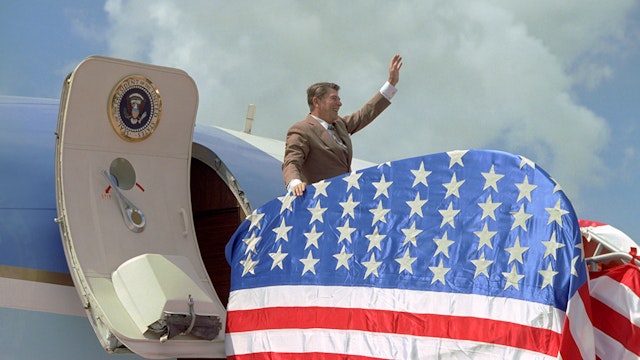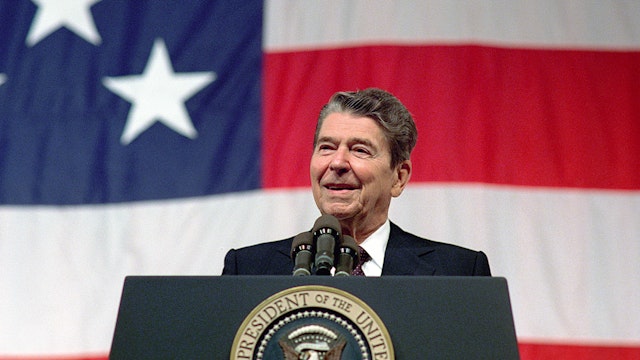The Presidency
Ronald Reagan and Mikhail Gorbachev
An Unlikely Pairing
The unlikely pairing of a devoted anti-Communist advocate of capitalism with a dyed-in-the-wool Marxist resulted not only in the most significant arms reduction treaty in history, but in a permanent change in U.S.-Soviet relations. Neither country, nor the world, would ever be the same again. Somehow, against all odds, “Ron and Mikhail,” as they eventually came to call each other, had found a way to make the planet safer after all.
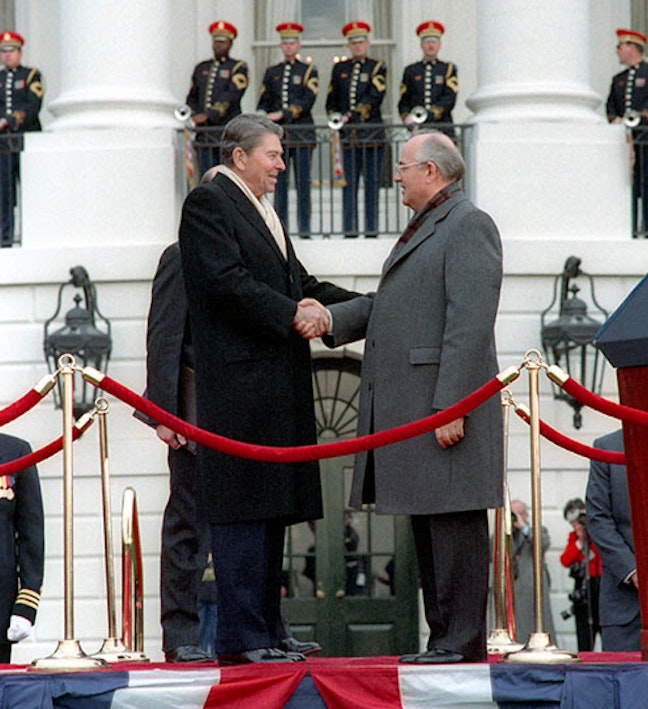
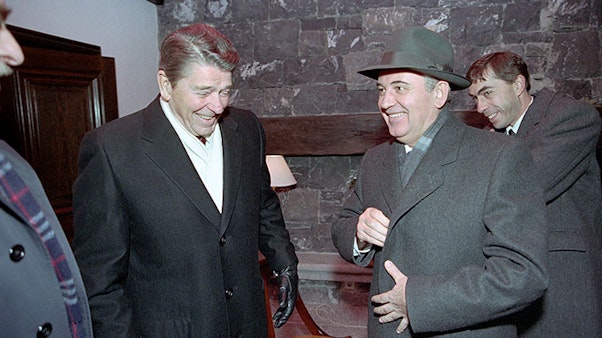

Evaporating Mistrust
When it came to communism, socialism and other systems that denied people their basic human rights, President Reagan was tough as nails. A devoted anti-communist, he was not afraid to say what needed to be said or do what needed to be done to bring freedom to people who were living under repressive regimes.
Of all the foreign policy achievements of the Reagan Presidency, none is more important, or had more lasting impact on the world, than the fundamental change in U.S.-Soviet relations. It was not due to luck or accident. Speaking of U.S.- Soviet relations and his steadfast determination to reduce arms, President Reagan would often say:
We don’t mistrust each other because we’re armed; we’re armed because we mistrust each other.
He believed that if the mistrust was eliminated, then so, too, could the dangerous, destabilizing weapons. President Reagan was confident that if he could just get his Soviet counterpart in a room and tell him face-to-face that America had no hostile intent, the mistrust would begin to evaporate.
Reagan knew traditional diplomacy wouldn’t suffice, so, to the dismay of career diplomats, he did what no president had before—while recovering from the 1981 assassination attempt, he handwrote a reply to Soviet leader Leonid Brezhnev’s hostile letter, seeking common ground.
However, Reagan had to be patient. Brezhnev died in 1982, followed by successors Yuri Andropov and Constantin Chernenko, both of whom died within two years. Finally, in 1985, Mikhail Gorbachev took power, giving Reagan the long-awaited opportunity to ease tensions and pursue meaningful arms reduction.


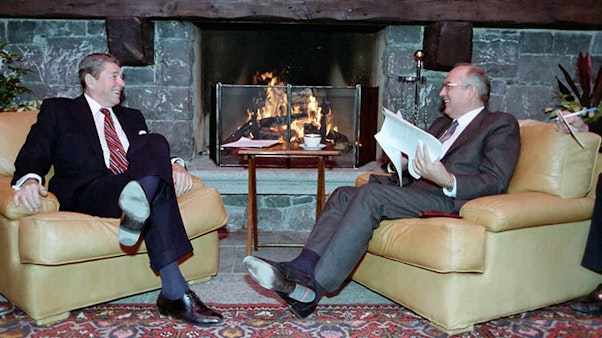
The First Meeting
The first of their five meetings was on “neutral turf.” It took place in Geneva, Switzerland in November 1985. In a small plain boat house just down a stone path from Fleur D’Eau, the grand chateau where their formal sessions took place, President Reagan and General Secretary Gorbachev sat down in two comfortable chairs in front of a roaring fireplace, and with only interpreters present, began to forge a relationship that would not only improve U.S.-Soviet relations, but would turn out to be the beginning of the end of Soviet domination of Eastern Europe and ultimately, of the Soviet Union itself.

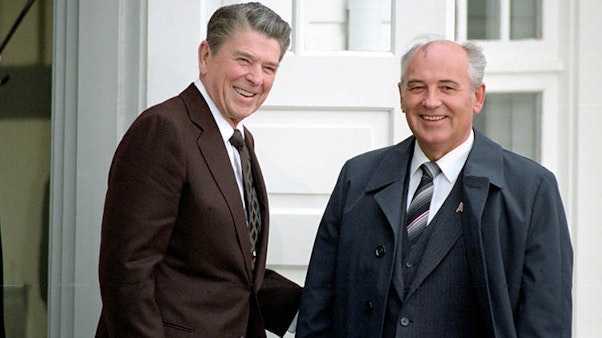

The Second Summit in Reykjavik, Iceland
Almost a year later, the two leaders got together again, this time in Reykjavik, Iceland. In a Summit meeting not long in the making, they met at Hofdi House, a picturesque waterfront structure that was once the French consulate.
There they came tantalizingly close to an agreement to eliminate all medium-range missiles based in Europe. But at the last minute, Gorbachev insisted that the United States abandon plans for a space-based missile defense system. Despite President Reagan’s offer to share the system’s technology with the Soviet Union so that both countries could be protected, Gorbachev dug in his heels and would not budge. The last thing Ronald Reagan would ever do would be to risk America’s safety for the sake of an agreement. The Summit was over.
Footage of President Reagan's Reykjavik Summit with Mikhail Gorbachev on October 11, 1986
The Second Summit in Reykjavik, Iceland Continued
The anger and sadness was etched in President Reagan’s face as he emerged from Hofdi House. There was chatter that this was the end of the Reagan-Gorbachev relationship, and that there would be no more Summits. But President Reagan knew better. Partly because of his natural optimism, and partly because he believed that Gorbachev shared his desire to make the world safer, he was certain that eventually talks would resume. The President directed his team to keep the dialogue going and to see whether the progress made in Reykjavik could be the basis for successful negotiations going forward. That’s exactly what happened.
It is a noteworthy measure of the confidence President Reagan had in the strength of his relationship with Gorbachev that just 8 months after Reykjavik, he boldly called on him to tear down the Berlin Wall.
Remarks on East-West Relations at the Brandenburg Gate in West Berlin
The Third Summit in Washington
Just as he expected, in December, 1987, President and Mrs. Reagan welcomed the Gorbachevs to Washington for the third Summit. This time, the mood was upbeat and even celebratory. In a glittering East Room ceremony on December 8th, the two leaders signed the historic INF Treaty, eliminating all nuclear-armed ground-launched ballistic and cruise missiles with ranges between 500 and 5,000 kilometers. For the first time ever, the amount of nuclear arms was actually being reduced rather than merely limited.


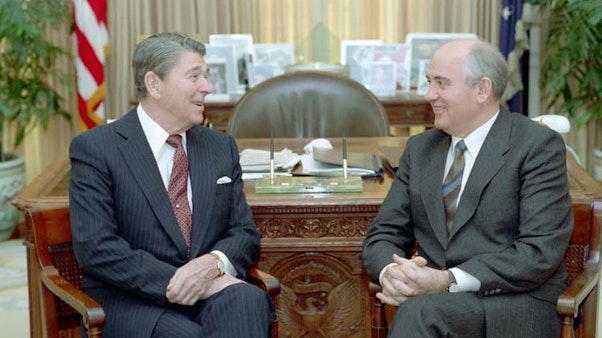
The Fourth Summit
In the Spring of 1988 the Reagans traveled to Moscow for Summit #4. From a historical perspective, the highlight of that trip was the Kremlin ceremony at which President Reagan and General Secretary Gorbachev signed the now-ratified INF Treaty, but the Reagans also found time to enjoy some cultural treats including the Bolshoi Ballet and a visit to a monastery.



The Final Summit
The final Summit during the Reagan Presidency was in December, 1988. In what some called a “handing off” of the official relationship, President Reagan and President-elect (Vice President) George Bush traveled to New York to meet with Gorbachev.

